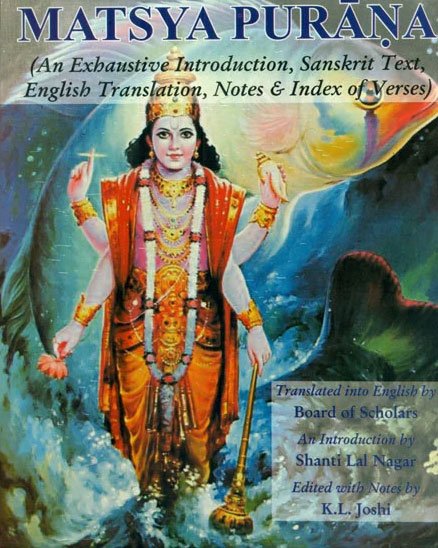The Matsya Purana (critical study)
by Kushal Kalita | 2018 | 74,766 words | ISBN-13: 9788171103058
This page relates ‘Myths and Legends (Introduction)’ of the English study on the Matsya-purana: a Sanskrit text preserving ancient Indian traditions and legends written in over 14,000 metrical verses. In this study, the background and content of the Matsyapurana is outlined against the cultural history of ancient India in terms of religion, politics, geography and architectural aspects. It shows how the encyclopedic character causes the text to deal with almost all the aspects of human civilization.
Part 1 - Myths and Legends (Introduction)
The myth and legend both normally denote traditional story. According to the Oxford dictionary, the term ‘myth’ denotes traditional story especially one concerning the early history of people or explaining some natural or social phenomenon and typically involving supernatural being or events.[1] On the other hand, the term ‘legend’ denotes traditional story which may sometimes be regarded as historical but unauthenticated.[2]
The word “legend” comes from the Latin word “legenda” which means things to be read. It means the story handed down from the past. It is believed that legends have a historical basis and resemble folk-tales in their contents. Elements of mythology and explanations of natural phenomena are attached to these stories. However, myths deal with the events which are inaccessible, events which are not based on fact. The characters of a myth are mostly supernatural beings. On the other hand, a legend is often based on facts no matter how much it is unauthenticated. In most of the cases it depicts historical characters and events. Time plays a very crucial role in displaying a matter as a myth or legend or a complete historical event. Due to long course of time historical events gradually turns into legends. Therefore, it is difficult to draw any clear line of distinction between myth and legends. Due to the absence of evidence and authenticity historical event of past can only be treated as myth or legend. It is possible that the stories of present time about our gods and goddesses may carry historical value but due to non availability of proof it is limited to the myth.
The Purāṇas have dealt with numerous mythical and legendary accounts. These mythical and legendary accounts enriched the Sanskrit literature of latter period as most of the poets are highly influenced by these. From the rich myths and legends of the two epics the Rāmāyaṇa and the Mahābhārata and also of the Purāṇas, most of the Sanskrit poets have done their literary works. In the Matsyapurāṇa different myths and legends are dealt with which carries great value. Among these accounts some are expressed as an independent chapter and some are inter woven with some descriptions of traditional history.
Footnotes and references:
[1]:
Julia Elliott, Oxford Dictionary & Thesaurus III, p.494
[2]:
Ibid.,p.430
